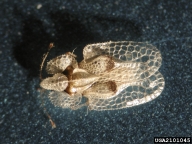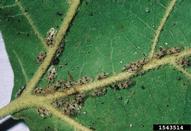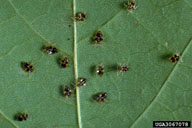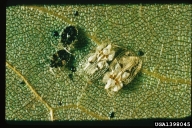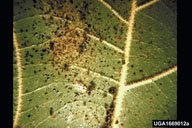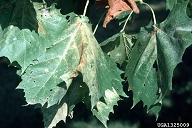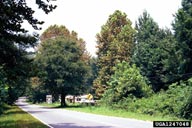Sycamore lace bug
Corythucha ciliata (Say) (Hemiptera: Tingidae)
Orientation to pest
Sycamore lace bug, Corythucha ciliata (Say), is a minor pest of American sycamore (Planatus occidentalis L.) in its native range in North America but is very important in Europe as an invasive species on urban plane trees. It has also invaded Australia, China, Turkey, and Chile. Adults overwinter under the bark flakes of sycamores. Feeding activity begins in early spring at leaf expansion of host plants. Eggs are laid on the underside of leaves. Nymphs and adults occur in colonies on the underside of foliage where they feed by sucking sap from plant cells. Feeding by low densities of lace bugs results in yellow stippling, starting along the mid-veins, similar in appearance to the damage caused by spider mites, but without webbing. Black fecal spots are also present on the undersides of leaves infested by lace bugs. Dense populations can cause a white or bronzed appearance to the leaves and premature leaf drop. In the northeast United States, there are two to four generations per year.
Hosts commonly attacked
The principal host of sycamore lace bug is American sycamore (P. occidentalis), but it occasionally feeds on ash (Fraxinus), hickory (Carya), and mulberry (Morus).
Distribution
This bug is native throughout the eastern USA and southern Canada. It is also invasive in Europe, Turkey, Australia, China, and Chile. Spread is likely due to tendency of adults to secrete themselves into crevices for overwintering, allowing them to be easily moved in crates or cargo between countries.
Images of the sycamore lace bug
| Figure 1. Adult of sycamore lacebug, Corythucha ciliate | Figure 2. Nymphs of sycamore lace bug | Figure 3. Adults of sycamore lace bug feed in groups on the undersides of leaves (note the black fecal spots) |
| Figure 4. Size of mature nymphs of sycamore lace bug (black, on left) as compared to adults | Figure 5. Close up showing the black fecal spots deposited by sycamore lace bug | Figure 6. Yellow stippling and bronzing of foliage caused by sycamore lace bug | Figure 7. Sycamore trees bronzed by feeding of sycamore lace bug |
Important biological control agents related to this pest species
Little is known of the specific natural enemies of the sycamore lace bug. The generalist predatory mirid Deraeocoris nebulosus (Uhler) is known to feed on sycamore lace bugs.
Web links for information on the sycamore lace bug
Articles
- Halbert, S. E. and J. R. Meeker. 1998, The Sycamore Lace Bug, Corythucha ciliata (Say) (Hemiptera: Tingidae). Entomology Circular No.387. Florida Dept. Agric. & Consumer Services, Division of Plant Industry (viewable at: http://www.fl-dof.com/publications/fh_pdfs/Sycamore%20Lace%20Bug.pdf)
- Wheeler, A. G., Jr., B. R. Stinner, and T. J. Henry. 1975. Biology and nymphal stages of Deraeocoris nebulosus (Hemiptera: Miridae), a predator of arthropod pests on ornamentals. Annals of the Entomological Society of America 68: 1063-1068.
- Horn, K. F., C. G. Wright, and M. H. Farrier. 1979. The lace bugs (Hemiptera: Tingidae) of North Carolina and their hosts. North Carolina Agricultural Experiment Station Technical Bulletin No. 257, 22 pp.
